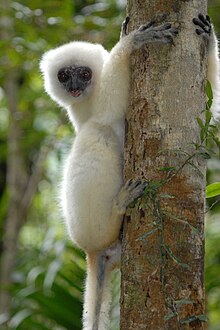Portal:Madagascar
The Madagascar Portal
Madagascar, officially the Republic of Madagascar, is an island country comprising the island of Madagascar and numerous smaller peripheral islands. Lying off the southeastern coast of Africa, it is the world's fourth largest island, the second-largest island country and the 46th largest country in the world. Its capital and largest city is Antananarivo. Following the prehistoric breakup of the supercontinent Gondwana, Madagascar split from Africa during the Early Jurassic, around 180 million years ago, and split from the Indian subcontinent around 90 million years ago, allowing native plants and animals to evolve in relative isolation; consequently, it is a biodiversity hotspot and one of the world's 17 megadiverse countries, with over 90% of wildlife being endemic. The island has a subtropical to tropical maritime climate. Madagascar was first settled during or before the mid-first millennium AD by Austronesian peoples, presumably arriving on outrigger canoes from present-day Indonesia. These were joined around the ninth century AD by Bantu migrants crossing the Mozambique Channel from East Africa. Other groups continued to settle on Madagascar over time, each one making lasting contributions to Malagasy cultural life. Consequently, there are 18 or more classified peoples of Madagascar, the most numerous being the Merina of the central highlands. Until the late 18th century, the island of Madagascar was ruled by a fragmented assortment of shifting sociopolitical alliances. Beginning in the early 19th century, most of it was united and ruled as the Kingdom of Madagascar by a series of Merina nobles. The monarchy was ended in 1897 by the annexation by France, from which Madagascar gained independence in 1960. The country has since undergone four major constitutional periods, termed republics, and has been governed as a constitutional democracy since 1992. Following a political crisis and military coup in 2009, Madagascar underwent a protracted transition towards its fourth and current republic, with constitutional governance being restored in January 2014. (Full article...) This is a Featured article, which represents some of the best content on English Wikipedia..
 The silky sifaka (Propithecus candidus) is a large lemur characterized by long, silky, white fur. It has a very restricted range in northeastern Madagascar, where it is known locally as the simpona. It is one of the rarest mammals on Earth. The silky sifaka is one of nine sifaka species (genus Propithecus), and one of four former subspecies of diademed sifaka (P. diadema). Studies in 2004 and 2007 compared external proportions, genetics, and craniodental anatomy supporting full species status, which has generally been accepted. The silky sifaka has a variable social structure, and lives in groups of two to nine individuals. It spends most of its day feeding and resting, though it also devotes a considerable amount of time to social behaviors, such as playing and grooming, as well as travelling. Females occasionally take priority over males during feeding. Like other eastern sifakas, it consumes mainly leaves and seeds, but also fruit, flowers, and even soil on occasion. It is a seasonal breeder and only mates one day a year during the start of the rainy season. As with other sifaka species, nonmaternal infant care is common. Group members of all ages and both sexes often groom, play with, occasionally carry, and even nurse infants that are not their own. The silky sifaka vocalizes frequently despite its moderately sized vocal repertoire consisting of seven adult calls. Like all other lemurs, it relies strongly on scent for communication. Males frequently scent-mark on top of scent marks made by other group members, particularly females. Males also gouge trees with their toothcomb (a special arrangement of the bottom, front teeth) prior to chest scent-marking. This chest marking results in males having brown-stained chests, the only visible trait that can be used to distinguish between adult males and adult females. (Full article...)Selected article -The 2009 Malagasy political crisis began on 26 January 2009 with the political opposition movement led by Antananarivo mayor Andry Rajoelina, which sought to oust President Marc Ravalomanana from the presidency. The crisis reached its climax in the 2009 Malagasy coup d'état when Andry Rajoelina was declared the president of the High Transitional Authority of Madagascar on 21 March 2009, five days after Ravalomanana transferred his power to a military council and fled to South Africa. The international community immediately condemned the leader and his ascension as unconstitutional, characterising the move as a coup. Financial support and foreign investments stopped, and the country fell into one of the worst economic crises in its history. The SADC and the African Union were designated to supervise Madagascar's political reinstatement. (Full article...)This is a Good article, an article that meets a core set of high editorial standards.
Lemurs' Park (also known locally as Parc de lémuriens à Madagascar) is a small botanical garden and lemur reserve covering 5 ha (12 acres), and is located 22 km (14 mi) southwest of Antananarivo, Madagascar. It was founded around 2000 by Laurent Amouric and Maxime Allorge. Most of its nine lemur species are free-ranging within the park, which also contains more than 70 of Madagascar's endemic plant species. The park is open to the public, offering guided tours as well as standard amenities, a gift shop, and a restaurant. Visitors can arrange transportation between downtown Antananarivo and Lemurs' Park on a private park shuttle. Most of the park's lemurs were confiscated pets, entrusted to the park by the Ministry of Water and Forests. The lemurs are rehabilitated and bred for reintroduction into the wild. The park also collaborates with Colas Madagascar and TOTAL Madagascar to provide environmental education to local primary school children and to plant native trees as part of a reforestation program. Most of the park's staff come from the neighboring communities. (Full article...)General images -The following are images from various Madagascar-related articles on Wikipedia.
Selected panoramaLandscape near Fianarantsoa, Madagascar.
TopicsCategoriesSelected pictureAssociated WikimediaThe following Wikimedia Foundation sister projects provide more on this subject:
Discover Wikipedia using portals | |||












































































